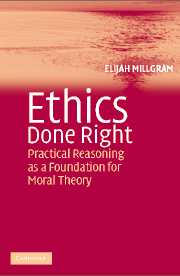Book contents
- Frontmatter
- Contents
- Acknowledgments
- Miscellaneous Frontmatter
- Introduction: The Method of Practical Reasoning
- 1 What's the Use of Utility?
- 2 Mill's Proof of the Principle of Utility
- 3 Does the Categorical Imperative Give Rise to a Contradiction in the Will?
- 4 Reasonably Virtuous
- 5 Murdoch, Practical Reasoning, and Particularism
- 6 Was Hume a Humean?
- 7 Hume on “Is” and “Ought”
- 8 Hume, Political Noncognitivism, and the History of England
- 9 Incommensurability and Practical Reasoning
- 10 Commensurability in Perspective
- 11 Varieties of Practical Reasoning and Varieties of Moral Theory
- References
- Index
Introduction: The Method of Practical Reasoning
Published online by Cambridge University Press: 12 November 2009
- Frontmatter
- Contents
- Acknowledgments
- Miscellaneous Frontmatter
- Introduction: The Method of Practical Reasoning
- 1 What's the Use of Utility?
- 2 Mill's Proof of the Principle of Utility
- 3 Does the Categorical Imperative Give Rise to a Contradiction in the Will?
- 4 Reasonably Virtuous
- 5 Murdoch, Practical Reasoning, and Particularism
- 6 Was Hume a Humean?
- 7 Hume on “Is” and “Ought”
- 8 Hume, Political Noncognitivism, and the History of England
- 9 Incommensurability and Practical Reasoning
- 10 Commensurability in Perspective
- 11 Varieties of Practical Reasoning and Varieties of Moral Theory
- References
- Index
Summary
In philosophy, choice of method matters. You're about to read an advertisement for a method: namely, that the right way to do moral philosophy is to start by working out your theory of practical reasoning. By way of introducing the book-length argument, I want first to explain what I mean by that. Then I'll give some reasons for using the method, and hand out some promissory notes for the reasons I can't give up front; I'll also flag some of the issues I won't be taking up here. By way of clearing the ground, I'll discuss so-called reflective equilibrium, which has been, for some time now, the method of choice, or anyway the default method, for moral philosophers of the analytic stripe. I'll briefly indicate the advantages my proposed method has over the reflective equilibrium competition.
Next I'll provide a site map for the volume, which will describe how the subsequent chapters advance the main argument. Almost all of these were originally written as freestanding papers, and have agendas of their own; since they are (with occasional exceptions) unrevised, their respective conclusions are not always the contributions I want them to be making to the argument of the book. Accordingly, I'll provide more or less chapter by chapter orientation and reading instructions. Finally, I'll wrap up by looking beyond the work I do in this volume, to some of the further possibilities of the Method of Practical Reasoning.
First, terminology. Substantive moral or ethical theories answer questions like: What is it morally permitted for me to do?
- Type
- Chapter
- Information
- Ethics Done RightPractical Reasoning as a Foundation for Moral Theory, pp. 1 - 32Publisher: Cambridge University PressPrint publication year: 2005



